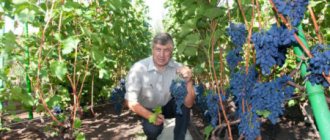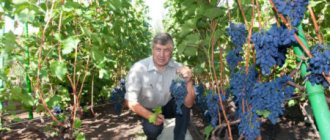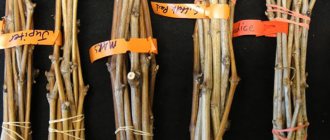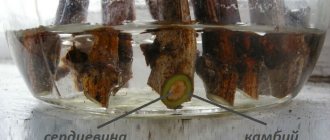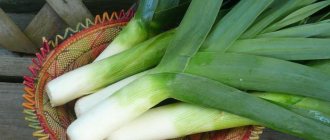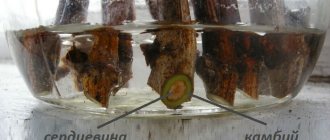When an avid summer resident hears the word “greenhouse,” he immediately imagines an abundance of all kinds of fruits that can be grown in this room. Now we will talk about the greenhouse, which is called “Harvest”.
Ready greenhouse
The photo shows the mentioned design.
Positive reviews left by gardeners for this product indicate that it has good qualities. Let's look at these characteristics.
What does growing include?
Growing grapes on a personal plot is a rather complex process. It includes a certain sequence of actions. In addition, in Russia there are climatic zones where only certain varieties of grapes are grown. Such zones include Siberia and the Urals.
If the natural conditions in a given area allow you to grow grapes, then the sequence of steps may be as follows:
- choice of location;
- purchase of planting material;
- soil preparation;
- landing;
- competent care.
The grapes should be planted on the southern, sunny side of the plot, since the vine is a very heat-loving plant. A very important factor is the absence of cold air currents, so in cool regions it is better to plant bushes close to the wall of the house or use artificial structures to protect against drafts.
First of all, you should choose a suitable grape variety that will feel comfortable in your region.
You should be very careful about the choice of variety and quality of seedlings. Hybrid varieties are well suited for the middle zone. Most of them were created by selection methods and have good frost resistance, strong immunity to diseases and high yields.
Low-lying and swampy areas are strictly contraindicated for grapes. If the soil is highly saline, then before planting grapes, the soil should be desalted by leaching.
Technology
Modern technology for growing grapes is based on methods that have been proven for many centuries. In addition to traditional methods, fundamentally new chemical fertilizers and effective drugs have been added to combat grapevine diseases. Once the planting site has been determined, the pits can be prepared. This work is always carried out in the fall.
The size of the planting hole is determined by the size of the root system of the seedling, and its depth, depending on the characteristics of the soil, varies from 50 to 80 centimeters. Heavy soils require less depth, and for sandy soil the depth of the hole can reach 70-80 centimeters. At the bottom of the hole it is necessary to pour a layer of fertile soil mixed with humus or manure. Opinions regarding the application of chemical fertilizers at this stage vary markedly.
When choosing a grape variety for planting in the middle zone, you should focus on frost resistance. In the European part of the country the following varieties will grow and develop well:
- mascot;
- Timur;
- crystal;
- Victoria;
- Donskoy agate.
These grape varieties can withstand winter cold down to – 23-260C. They are unpretentious, have good yields and are resistant to many types of diseases.
It is better for beginning winegrowers to start by planting green grapes. It is less demanding than chokeberry in terms of environmental conditions and care.
Agricultural technology
Agricultural technology, by definition, is a set of techniques and measures that ensure high yields. These include:
- bush formation;
- plant nutrition;
- pruning
Agrotechnical measures also include caring for the health of grape bushes and the prevention of various diseases. Before planting, it is recommended to harden off the seedlings for several days. This procedure is carried out in the fresh air only at positive air temperatures. The seedlings are placed under a canopy to protect them from direct sunlight. This article will tell you what kind of soil grapes like.
For good growth and good health, grape plantations need grape trellises.
For proper formation of the bush, trellises should be used. If the bushes are planted in rows, you can use dug posts with strong wire stretched between them. A grapevine is tied to it. Grapes require abundant watering, so a lack of water can lead to the death of the bush. The soil around the planting should be carefully loosened, removing weeds. With proper care, after 2 years you can get the first harvest, and the grape bush will reach maximum fruiting in 3-4 years.
Phosphorus and potassium fertilizers should be used for fertilizing. They should be used depending on the type of soil and grape variety. To protect against diseases and certain types of insects, the vineyard should be sprayed with fungicides. This procedure should also be performed on healthy plants as a preventive measure.
Advantages
The “Harvest” greenhouse has a fairly long service life. This is due to the high strength of its frame, made of galvanized metal profile.
Since the “Harvest” greenhouse is an arched structure, it has a rather original way of attaching the covering panels: polycarbonate is mounted on the frame without the help of self-tapping screws.
Foundation
This design can freely change its dimensions. For this purpose, the designers have provided special modules. This property is very convenient, since it makes it possible to increase the amount of green space indoors without extra financial costs. In addition, it will take quite a bit of time to complete these actions.
Assembly and installation of the “Harvest” greenhouse is not difficult at all. Every summer resident can carry out installation operations with his own hands, without turning to specialists.
The photo shows the frame of the greenhouse, on which the polycarbonate has not yet been mounted.
Moreover, the polycarbonate with which the greenhouse is sheathed acquires the shape and dimensions required for the work at the factory. Consequently, the customer does not need to cut and cut the building material himself.
This product has a relatively low price. Along with ease of installation, this makes it possible to save quite a lot of money. However, one should not think that low cost determines the quality of the design. The “Harvest” greenhouse is made to last. In addition, both polycarbonate and metal profiles for the frame undergo thorough testing before production begins.
These are the advantages of the “Harvest” greenhouse. However, nothing is perfect, including this design. Reviews in which not very satisfied consumers criticize this product indicate the presence of shortcomings. Let's consider the negative characteristics of the greenhouse.
Kinds
In addition to fruit grapes, the berries of which are edible and used in winemaking, there are varieties that perform a purely decorative function. Such grapes are widely used in landscape design.
Wild
Wild grapes are a fast-growing vine that can be planted in almost any soil. To plant wild grapes, it is enough to dig a hole up to 50 centimeters deep and fill it with fertile soil mixed with humus. This plant can be used for the following purposes:
- organization of hedges;
- gazebo decoration;
- wall decoration;
- installation of green arches.
The plant is unpretentious and does not require special care. It is enough to water it 3-4 times during the season. For normal development of the vine, strong trellises will be required.
Fruitful
Fruitful or cultivated grapes are an extremely valuable food product. Grapes are consumed in their natural form, used to obtain juice and are the main raw material in winemaking. Grapes and natural wine, in small quantities, are used as remedies for certain diseases. Glucose, which grapes are rich in, is a powerful biological stimulant, so grapes are very useful for reducing body tone. Conventionally, grapes can be divided into green and black varieties.
Decorative (girlish)
This beautiful plant is called Maiden grape because its flowers do not require pollination. In Russia, five-leaf Virginia grapes have gained great popularity. It is not afraid of frost and can grow in any soil. This plant has the following advantages:
- looks beautiful all season long;
- forms a thick green curtain;
- not afraid of cold weather;
- can grow in the shade and in the sun;
- grows 2-3 meters per year.
It is distinguished from grapes by its complex five-fingered leaves and small suckers on the tendrils that form on the shoots.
Despite all the advantages, growing Maiden grapes should be done with caution. Its strong root system can cover a large area and other cultivated plants simply do not have enough nutrition. In addition, vigorous shoots of maiden grapes falling under slate or tiles can simply destroy the building.
How is it structured, how does it work?
The high efficiency of drip tape for irrigation is achieved by the simplicity of its design. It consists of the following elements:
Filter. Installed on the water inlet side. Used to clean it and protect the entire system from suspended particles.- Labyrinth. It is created from the drip tape itself. Due to it, water pressure is stabilized.
- Water container.
- A system of holes necessary to supply water directly to the planting sites.
- Connecting fittings. Used to connect several highways into a single network.
The drip tape is connected to a container or pool of water. Due to the pump, water flows inside, purified from large particles of dirt using an inlet filter. After cleaning, the water enters the labyrinth, which stabilizes the water pressure, and from it into the hose, where it comes out through many holes.
The same pressure throughout the system allows the water to be dosed equally at the beginning, middle and end of the irrigation system. It is possible to further adjust the dosage in certain areas. This is done by adjusting the opening of the holes.
Planting methods
There are several ways to grow grapes. A fruitful bush can be grown in the following ways:
- cuttings;
- seeds;
- seedlings.
Each method has its pros, cons and agrotechnical care measures.
Cuttings
Cuttings for planting begin to be prepared in the fall, when all the foliage has fallen. To do this, a piece of up to 60 centimeters long and up to 1 centimeter in diameter is cut from the vine. There should be from 4 to 8 buds on it. Grape cuttings are stored in a cool place in damp sand or a damp cloth.
Before planting, the lower part of the cutting is placed in a container with a root growth stimulator. After the sprouts appear, the cuttings can be planted in holes. With good watering and air temperatures from +20 to +250C, the cuttings take root and the formation of a full-fledged bush begins.
Technologies for rooting grape cuttings are described at this link.
Seeds
Any grape seed that finds itself in the right conditions can grow into a full-fledged plant. For self-planting, it is better to use seeds of hybrid varieties that have good immunity to diseases. Seeds should only be taken from fully ripe berries. They should be large and brownish in color. The seeds should be washed, wrapped in damp gauze and placed in the refrigerator.
According to the theory, you can grow a grape seedling from a seed, but not all varieties are suitable for this; it is better to grow from hybrid varieties, although they are not common.
Cracks that appear on the seeds indicate that they are ready for planting. Next, the seeds are placed in pots with a mixture of sand and humus, which should be placed near a sunny window. The first shoots may appear in a week. At the end of May, the plants can be transplanted into large pots and placed on the balcony. In autumn, the plants are transplanted into open ground.
Seedlings
This method is considered the most popular among gardeners. Correct implementation of all procedures guarantees the cultivation of a strong, healthy and productive bush. Planting of seedlings can be carried out both in spring and autumn. The technique is almost the same, only autumn planting requires the use of insulation to preserve the seedlings. It is believed that a properly prepared pit guarantees 90% success. In this case, you need to follow some rules:
- for clay soils, crushed stone or broken brick should be added to the pit;
- sandy loam does not require drainage, but nitrogen fertilizers must be added;
- compost, humus and superphosphate are added to sandy soils.
When choosing seedlings, you should pay attention to the presence of damage and fungus. The roots must be at least 10 centimeters long and be elastic to the touch. The growth should have from 4 to 6 buds.
Emitter drip tape
We recommend reading our other articles
- Strawberry variety Kimberly
- Vyuga cabbage variety
- How to spray tomatoes against late blight
- Cherry variety Lyubskaya
Emitter tape for drip irrigation is the most modern type and differs from other options in that it has separate, flattened droppers. They are built into the tape at a certain distance from each other. The tape is resistant to contamination thanks to special turbulent flows that clean the dropper.
Photo of Neo Drip emitter drip tape
Flaws:
- High price.
- If unwinding or installing incorrectly, the tape can be damaged.
The most popular emitter tapes are Neo Drip, Hirro Drip, and Pestan.
Where to grow
Grapes can be grown in the following conditions:
- Location on;
- in a greenhouse;
- at home.
In the open ground
To obtain a good harvest, grapes are usually grown in a garden plot or in open ground. The grapes take root in almost any soil; you just need to add a certain amount of fertile soil with the addition of mineral and organic fertilizers to the planting hole.
In the greenhouse
Planting grapes in greenhouses gives very good results. Transparent polycarbonate is usually used for their manufacture. It provides excellent protection for the vines from adverse weather conditions and transmits almost the entire spectrum of solar radiation.
In the apartment
It is quite possible to grow some grape varieties indoors. For this, self-pollinating varieties are usually used. For planting, it is best to use cuttings that are placed in a substrate of river sand, humus and turf, taken in equal quantities. First, planting is done in small pots, and after the development of the root system, the plant can be transplanted into a pot with a diameter of up to 40 centimeters. It should be taken into account that the constant introduction of wintering plants into the apartment during the onset of cold weather will not save, and will even harm the plants.
Reasons and what to do if the Venturi pump stops working
Venturi injectors are trouble-free pumps. They have no moving parts, friction of parts, or electrical components. Therefore, the main failure of the pipe is the lack of pressure difference in it, due to which fertilizers are supplied to the drip irrigation system.
Ways to solve the problem for different types of injector connections:
| Straight | Via bypass |
| increase the pressure in the line, reduce the pressure in the watering system by turning off part of it | close the valve on the main line, increase the pressure at the inlet to the pump, reduce the outlet pressure by turning off part of the irrigation system |
To monitor the pressure, it is recommended to install pressure gauges at the bypass inlet and outlet.
How to install or lay it correctly?
It is very easy to install the finished drip tape yourself. This is done as follows:
- Connect the outlet pipe to the tap or container with a ball valve.
- Attach a filter to the tap outlet.
- Attach a pipe to the filter outlet, perpendicular to the ground.
- Make holes in this pipe for the connectors. The holes should be exactly parallel to each row of beds.
- Connect the connectors to the pipe.
- Apply ribbons to the connectors and connect them.
- Plug the ends of the hoses.
- Lay the tapes along the entire length of the beds, taking into account the distance between the plants and the emitters.
- Secure the tapes with fasteners or sprinkle with soil.
- Flush the system.
It is necessary to lay the tape so that all holes are directed straight up.
Rating of the best products on the market
When choosing, you should also take into account the ability of the tapes to irrigate open and closed areas, that is, versatility. In the rating of universal irrigation systems, the following models are considered the best.
Green Helper GN-023N
This model is produced in lengths starting from 100 meters . There are 64 emitters or slits per length. The model is available in slot and emitter types. Suitable for use on open hard ground or in a greenhouse. Also, corrosion resistance allows the tape to be used when installed directly into the ground.
Among the advantages are the high quality of the material, resistance to creases and twisting. The main disadvantage is the high cost. The price of a standard 100 reel starts from 3,500 rubles.
Presto-PS Blue Line
This model of slotted tape has a standard length of 100 m . Made from black propylene, UV resistant. Universal class products. Available with slot spacing of 10, 20, 30 cm. Suitable for external and underground installation.
The advantage of the model is its resistance to pressure of 1.8 Bar. The main disadvantage is the non-standard diameter. The end of the hose is very difficult to pull onto standard adapters. The price of a standard reel of this model starts from 5,000 rubles.
BOUTTE
This model is available in lengths from 100 m, with a diameter of 16 mm . It has 3 options for the location of emitters: 10, 20, 30 cm. Produced from black polyethylene, resistant to chemical reagents. The main feature is versatility.
The product can be used when connected to a pump, container or water tap. The main disadvantage is the need for frequent fastening; the hose twists over long distances. The price of products starts from 750 rubles.
How to do it yourself?
Many gardeners place more trust in self-made irrigation systems. You can make drip tape for irrigation yourself.
What will you need?
To make your own ribbon you will need:
- plastic pipes with a diameter of 20 mm, their length should take into account all rows of beds;
- connecting plastic corners for pipes;
- ball valve;
- plastic plugs;
- water container.
The tools you will need are a drill with a drill bit with a diameter of 1-1.5 mm and a soldering iron for plastic pipes.
Manufacturing process
The manufacture of a drip irrigation system begins with marking the site. It is necessary to measure the length of each row and the distance between plants. Further:
Connect the pipes together using corners, according to the site diagram.- Taking into account the predetermined distance between the plants, drill holes in the pipe along the entire length, for example 40 cm.
- Seal the ends of the pipes with plastic plugs.
- Connect an inlet pipe with a ball valve to the system.
- Connect the end of the pipe to a water container.
This is the simplest drip irrigation system. It can be supplemented with regular medical droppers. Each dropper will need to be inserted into a hole. This approach will allow you to regulate water flow in each area.
How to clean?
During operation, the belt collects deposits in its cavity. They also accumulate in the outlet openings.
Washing is carried out as follows:
- open all the plugs at the ends of the tapes;
- turn on the water at a pressure of 0.6-1 m per second.
This performs a general flushing of the system. You can also regularly clean the holes to remove salts and deposits. To do this, use a hydrogen peroxide solution.
The solution is prepared from a ratio of 1 to 40 . The mixture can be cleaned only after the plants have been fertilized with copper-containing products and not earlier than 24 hours.
